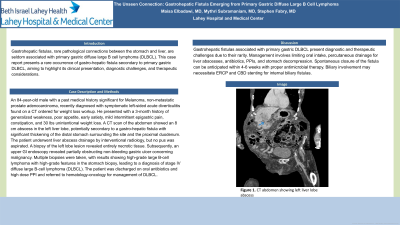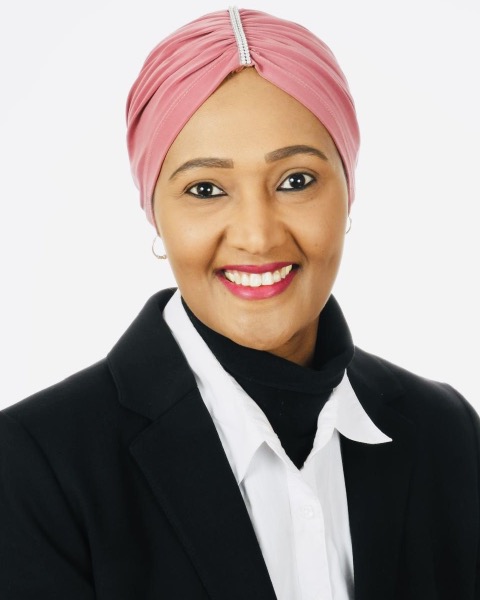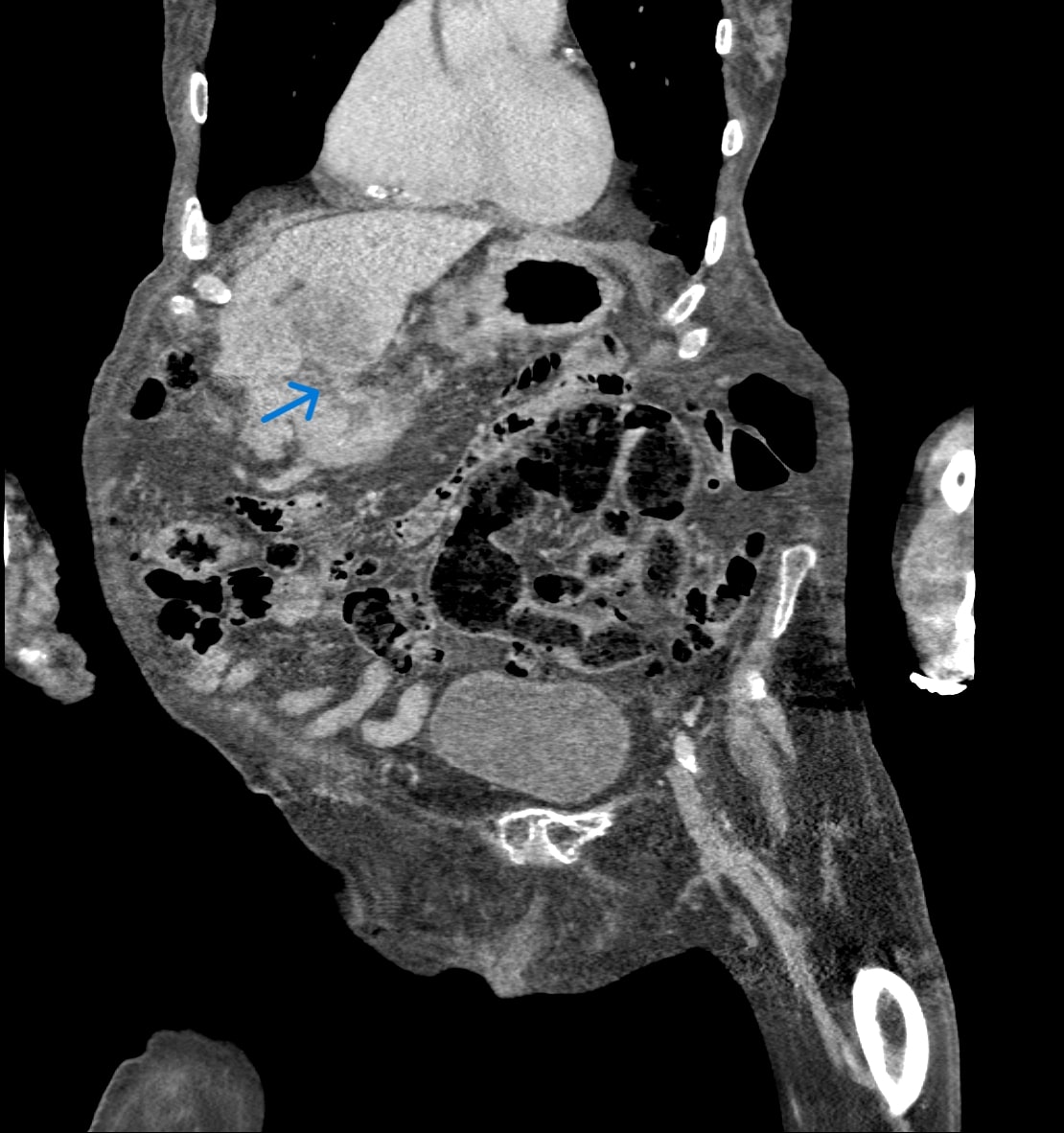Monday Poster Session
Category: Stomach
P3364 - The Unseen Connection: Gastrohepatic Fistula Emerging from Primary Gastric Diffuse Large B Cell Lymphoma
Monday, October 28, 2024
10:30 AM - 4:00 PM ET
Location: Exhibit Hall E

Has Audio

Maisa E. Elbadawi, MD
Lahey Hospital and Medical Center
Dracut, MA
Presenting Author(s)
Maisa E. Elbadawi, MD1, Stephen Fabry, MD2, Mythri Subramaniam, MD2
1Lahey Hospital and Medical Center, Dracut, MA; 2Lahey Hospital and Medical Center, Burlington, MA
Introduction: Gastrohepatic fistulas, rare pathological connections between the stomach and liver, are seldom associated with primary gastric diffuse large B cell lymphoma (DLBCL). This case report presents a rare occurrence of gastro-hepatic fistula secondary to primary gastric DLBCL, aiming to highlight its clinical presentation, diagnostic challenges, and therapeutic considerations.
Case Description/Methods: An 84-year-old male with a past medical history significant for Melanoma, non-metastatic prostate adenocarcinoma, recently diagnosed with symptomatic left-sided acute diverticulitis found on a CT ordered for weight loss workup. He presented with a 3-month history of generalized weakness, poor appetite, early satiety, mild intermittent epigastric pain, constipation, and 30 lbs unintentional weight loss. A CT scan of the abdomen showed an 8 cm abscess in the left liver lobe, potentially secondary to a gastro-hepatic fistula with significant thickening of the distal stomach surrounding the site and the proximal duodenum. The patient underwent liver abscess drainage by interventional radiology, but no pus was aspirated. A biopsy of the left lobe lesion revealed entirely necrotic tissue. Subsequently, an upper GI endoscopy revealed partially obstructing non-bleeding gastric ulcer concerning malignancy. Multiple biopsies were taken, with results showing high-grade large B-cell lymphoma with high-grade features in the stomach biopsy, leading to a diagnosis of stage IV diffuse large B-cell lymphoma (DLBCL). The patient was discharged on oral antibiotics and high dose PPI and referred to hematology-oncology for management of DLBCL.
Discussion: Gastrohepatic fistulas associated with primary gastric DLBCL present diagnostic and therapeutic challenges due to their rarity. Management involves limiting oral intake, percutaneous drainage for liver abscesses, antibiotics, PPIs, and stomach decompression. Spontaneous closure of the fistula can be anticipated within 4-6 weeks with proper antimicrobial therapy. Biliary involvement may necessitate ERCP and CBD stenting for internal biliary fistulas.

Disclosures:
Maisa E. Elbadawi, MD1, Stephen Fabry, MD2, Mythri Subramaniam, MD2. P3364 - The Unseen Connection: Gastrohepatic Fistula Emerging from Primary Gastric Diffuse Large B Cell Lymphoma, ACG 2024 Annual Scientific Meeting Abstracts. Philadelphia, PA: American College of Gastroenterology.
1Lahey Hospital and Medical Center, Dracut, MA; 2Lahey Hospital and Medical Center, Burlington, MA
Introduction: Gastrohepatic fistulas, rare pathological connections between the stomach and liver, are seldom associated with primary gastric diffuse large B cell lymphoma (DLBCL). This case report presents a rare occurrence of gastro-hepatic fistula secondary to primary gastric DLBCL, aiming to highlight its clinical presentation, diagnostic challenges, and therapeutic considerations.
Case Description/Methods: An 84-year-old male with a past medical history significant for Melanoma, non-metastatic prostate adenocarcinoma, recently diagnosed with symptomatic left-sided acute diverticulitis found on a CT ordered for weight loss workup. He presented with a 3-month history of generalized weakness, poor appetite, early satiety, mild intermittent epigastric pain, constipation, and 30 lbs unintentional weight loss. A CT scan of the abdomen showed an 8 cm abscess in the left liver lobe, potentially secondary to a gastro-hepatic fistula with significant thickening of the distal stomach surrounding the site and the proximal duodenum. The patient underwent liver abscess drainage by interventional radiology, but no pus was aspirated. A biopsy of the left lobe lesion revealed entirely necrotic tissue. Subsequently, an upper GI endoscopy revealed partially obstructing non-bleeding gastric ulcer concerning malignancy. Multiple biopsies were taken, with results showing high-grade large B-cell lymphoma with high-grade features in the stomach biopsy, leading to a diagnosis of stage IV diffuse large B-cell lymphoma (DLBCL). The patient was discharged on oral antibiotics and high dose PPI and referred to hematology-oncology for management of DLBCL.
Discussion: Gastrohepatic fistulas associated with primary gastric DLBCL present diagnostic and therapeutic challenges due to their rarity. Management involves limiting oral intake, percutaneous drainage for liver abscesses, antibiotics, PPIs, and stomach decompression. Spontaneous closure of the fistula can be anticipated within 4-6 weeks with proper antimicrobial therapy. Biliary involvement may necessitate ERCP and CBD stenting for internal biliary fistulas.

Figure: Image showing Gastro-hepatic Fistula
Disclosures:
Maisa Elbadawi indicated no relevant financial relationships.
Stephen Fabry indicated no relevant financial relationships.
Mythri Subramaniam indicated no relevant financial relationships.
Maisa E. Elbadawi, MD1, Stephen Fabry, MD2, Mythri Subramaniam, MD2. P3364 - The Unseen Connection: Gastrohepatic Fistula Emerging from Primary Gastric Diffuse Large B Cell Lymphoma, ACG 2024 Annual Scientific Meeting Abstracts. Philadelphia, PA: American College of Gastroenterology.
